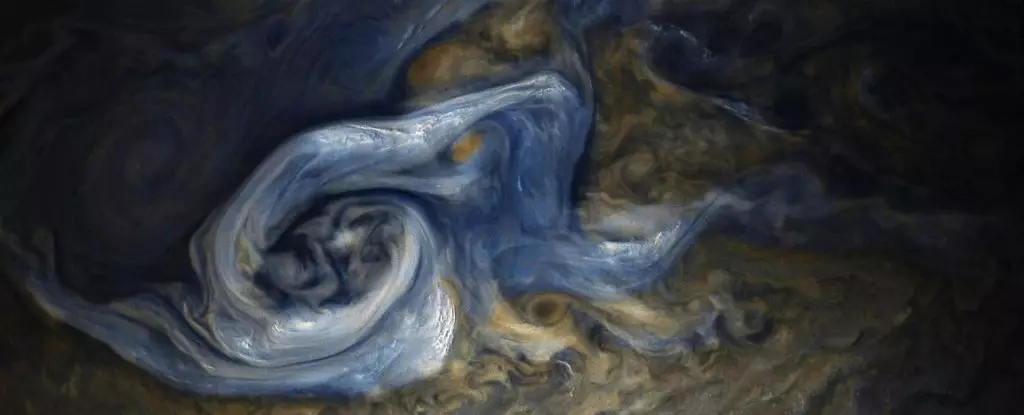Jupiter, the gas giant of our Solar System, has always captivated astronomers and enthusiasts alike with its stunning bands of clouds and colossal storms. Despite its breathtaking beauty, the complexities of Jupiter’s atmospheric phenomena often elude easy understanding. Unlike Earth, where weather patterns are relatively predictable, Jupiter’s atmosphere showcases a chaotic, tempestuous environment, characterized by intense storms and colossal lightning flashes. Recent scientific explorations, particularly through NASA’s Juno spacecraft, have led to some astonishing revelations about the gas giant’s atmospheric composition, including the peculiar discovery of “mushballs.”
These mushballs, essentially clumps of wet ice comprising ammonia and water, possess a texture reminiscent of slushy treats. This surprising phenomenon might hold the key to explaining why ammonia is distributed so unevenly across Jupiter’s atmosphere as well as those of its planetary neighbors—Saturn, Uranus, and Neptune. Such insights not only deepen our understanding of Jupiter but also challenge our assumptions about the atmospheric dynamics that govern planetary behavior throughout the Solar System.
The Birth of the Mushball Hypothesis
The genesis of the mushball concept dates back to 2020 when scientists began analyzing data collected by the Juno probe. They posited a groundbreaking explanation for the unconventional distribution of ammonia and water in Jupiter’s atmosphere. According to their theory, the tremendous storms that plague Jupiter propel water vapor high into the atmosphere, where it encounters ammonia gas. The intense cold conditions up there allow the combined particles of ammonia and water to coalesce into mushballs, which then descend back through the atmosphere.
Heidi Becker, a planetary scientist at NASA’s Jet Propulsion Laboratory, elaborated on this by explaining how the ammonia effectively acts like antifreeze at certain altitudes, allowing for unique cloud dynamics that do not exist on Earth. The result is an electrified atmosphere that challenges our fundamental understanding of cloud formation and weather phenomena. This conceptual leap prompted an intense period of inquiry, as researchers like Chris Moeckel sought to either validate or refute the mushball hypothesis, ultimately finding it resilient to rigorous scrutiny.
Data-Driven Revelations
In an exhaustive effort to confirm this theory, Moeckel and his colleagues delved deep into observational data from both Juno and the Hubble Space Telescope. Their investigations focused on a powerful lightning storm observed in July 2017, capturing data across various frequencies and wavelengths. While Jupiter’s atmospheric activity often appears to be shallow—spanning just 10 to 20 kilometers below the cloud tops—a deeper examination revealed striking insights into the planet’s meteorological depths.
The storms could penetrate much further into the troposphere, transporting water and ammonia through complex vertical motions. These findings led to a critical understanding: Jupiter’s upper atmosphere does not accurately represent its overall atmospheric conditions. Therefore, if we wish to piece together the complex dynamics of such otherworldly weather systems, we must look beyond the cloud tops to appreciate the interactions occurring several kilometers deep.
Mechanisms of Ammonia Transport
The newly introduced concept of mushballs fundamentally revolutionizes our understanding of ammonia distribution in Jupiter’s atmosphere. As these unique structures form and descend, they transport ammonia from lofty heights down to depths of approximately 150 kilometers. Before this hypothesis emerged, the means through which ammonia was depleted from the atmosphere remained a mystery. Mushballs present a compelling and coherent narrative; they are both the answer and the act of transport, stirring waters from higher altitudes into the planet’s core.
For the mushball theory to hold water—figuratively and literally—certain atmospheric conditions must converge uniquely. Strong updrafts are necessary to facilitate the transport of water vapor, and rapid mixing is required for mushballs to form sufficiently large to endure the descent through Jupiter’s turbulent atmosphere. Such intricate interactions serve as a reminder of nature’s complexity and unpredictability, reflecting similar mechanisms occurring in other giant planets across our Solar System.
The Broader Implications for Planetary Science
The implications of this research extend far beyond Jupiter. As scientists analyze other gas giants and exoplanets, the possibility that similar atmospheric dynamics might exist invites exciting prospectives for planetary science. The mushball phenomenon challenges established theories and suggests that we should reconsider what defines weather phenomena across diverse celestial bodies.
Understanding Jupiter’s haunting weather systems broadens our comprehension of atmospheric behavior in the universe, presenting a captivating inquiry into whether mushball-like processes could exist beyond our Solar System. As we continue our quest to unveil the mysteries harbored within Jupiter and its siblings, further exploration will not only illuminate the intricacies of these planets but may also redefine our perspectives on atmospheric science in general.

